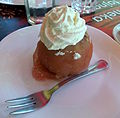 Tufahija with whipped cream | |
| Type | Dessert |
|---|---|
| Region or state | Balkans |
| Main ingredients | Walnuts, apples, water, sugar |
Tufahije (singular: tufahija) is a dessert made of walnut-stuffed apples poached in sugar water. It is very popular in Bosnia and Herzegovina, Serbia, Bulgaria, and Croatia.
Contents
The Bulgarian pechani yabalki are also stuffed with walnuts, but are usually baked, not poached. [1]


